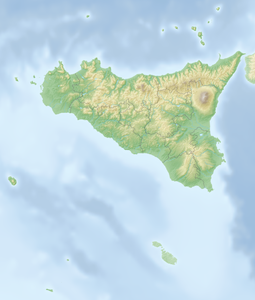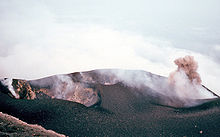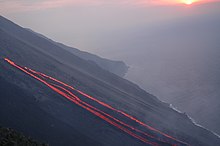Stromboli
| Stromboli | ||
|---|---|---|
|
Stromboli September 2009 |
||
| height | 926 m slm | |
| location | Aeolian Islands (near Sicily , Italy ) | |
| Coordinates | 38 ° 48 '14 " N , 15 ° 13' 24" E | |
|
|
||
| Type | Stratovolcano | |
| Last eruption | August 28, 2019 | |
| Normal way | Dangerous, marked footpath | |
Stromboli is an Italian island with the same active volcano type of a stratosphere or layer volcano . The island is located in the Mediterranean north of Sicily .
Stromboli and its neighboring islands Lipari , Salina , Vulcano , Panarea , Filicudi and Alicudi belong to the archipelago of the Aeolian or Lipari Islands in the Tyrrhenian Sea . The island belongs to the municipality of Lipari in the metropolitan city of Messina .
The height of the almost conical island rising steeply from the water is 926 meters from sea level, in other documents 918 meters and 968 meters are given. The cone of the Stromboli volcano rises about 3000 meters from the seabed. The area of the island is only 12.6 square kilometers, which is unusually small for this altitude.
The island
The name of the island has developed from the Greek word strongylē ( ancient Greek Στρογγύλη , "the round island").
Stromboli can be reached regularly by ship from Naples and the port cities of Milazzo and Messina in Sicily . In the holiday season, speedboats go from the coast of Calabria (port: Tropea ) to the volcanic islands.
The island has a population of 572 people (as of the 2001 census). There are two localities on the island of Stromboli: The districts of Scari, San Vincenzo, Ficogrande, Piscità and San Bartolomeo in the northeast have practically grown together today and are therefore subsumed under the place name Stromboli. About 540 permanent residents live there. Ginostra is located in the southwest and is not connected to Stromboli by land, unless you cross the volcano. Ginostra has only 30 inhabitants and can be reached by boat or hydrofoil . Cars hardly exist in either place. In Ginostra there are only narrow footpaths and in Stromboli electric mini vans and motorized tricycles to supply the population as well as scooters for the residents are allowed. On the northwest side of the island is the "Sciara del Fuoco" ("fire slide"), at the upper end of which are the craters and over which the lava of the volcano sometimes flows down into the sea. Despite the countless tourists and researchers who visit the volcano, the island has retained much of its originality.
Almost two kilometers northeast of the island, a small uninhabited rock juts out of the sea, the Strombolicchio , on which there is only a lighthouse. The Strombolicchio is the solid, permanent core of an earlier volcano.
To this day, the residents of Stromboli are proud that the Hollywood star Ingrid Bergman stayed on the island in 1949 to direct the melodrama Stromboli under the direction of Roberto Rossellini . The film impressively shows how poor the island was back then. The house where Bergman and Rossellini stayed has a plaque.
Vegetation geography
In terms of vegetation, one can distinguish three characteristic zones on Stromboli:
- The lower slope zone stretches from sea level to around 100 meters. Here are the settlement areas of San Vincenzo and San Bartolo on the northeast coast and, on the opposite southwest coast, the small town of Ginostra. There are still vines and olive groves here. In the past, this cultural zone with agricultural use extended up to a height of 600 meters on the mountain flanks, recognizable by the terracing of the slopes, which is now largely overgrown .
- Above the lower slope zone, the area no longer used for agriculture joins the typical macchia . Low hardwood plants, thorn bushes, gorse and post-cane vegetation predominate here. Because of the predominance of pile tube vegetation, this zone, which extends up to about 600 meters up the mountain, is often called the reed zone.
- The plant-free and ash-covered summit area, in which the crater terrace is located, begins above about 600 meters sea level. The almost complete lack of vegetation is due to the loose and repeatedly relocated fine ashes and sands. Due to the action of volcanic gases and the constant, more or less violent ash ejections, especially in the area of the Sciara del Fuoco, which stretches steeply from the crater terrace into the sea, no vegetation can develop here.
geology
Around 40,000 years ago, the Paleo-Stromboli erupted in the Young Pleistocene . The remnant of a possibly older volcano that remained as a chimney filling is the Strombolicchio, which lies 1500 meters off the northeast coast in the sea . At the end of the activity of the Paleo-Stromboli, a volcanotectonic collapse formed a caldera of around 1800 meters × 3000 meters, which today marked by the Sierra i Vàncori, the Paleo-Stromboli caldera open to the sea.
Within this caldera, a new volcano subsequently formed , the older Neo-Stromboli, eccentrically nested in the old caldera, whose first eruption began about 10,000 years ago. In the course of its activity, the Neo-Stromboli filled the Paleo-Stromboli caldera almost completely, whereby, in contrast to the current activity of the Stromboli, abundant lavas flowed out. 5000 to 6000 years ago, at the end of the activity of the older Neo-Stromboli, a caldera collapse occurred, albeit a smaller one, through which the Sciara del Fuoco rift formed, a so-called "hanging caldera" on the northwest slope of the volcano.
After the collapse of this Neo-Stromboli caldera around 5000 years ago, the younger Neo-Stromboli formed eccentrically at its southeast end as the active volcano today.
Activity of the Stromboli
The Stromboli is always active. At irregular intervals (a few minutes to every hour) there are larger and smaller eruptions from several crater openings . The ejected material usually falls back into the crater or it partially rolls over the Sciara del Fuoco into the sea.
This regular ejection of lava scraps, cinder and ash is so typical of Stromboli that volcanic activity of this type is called Strombolian or Strombolian activity . This continuous activity, unique in its regularity worldwide, is based on the phenomenon of two-phase convection: At a certain height of the chimney, the vapor pressure of the gases is greater than the weight pressure of the liquid above the gases. The resulting gas bubbles rise and, when they burst, tear shreds of magma with them on the surface. The degassing increases the density of the melt, which temporarily prevents further degassing while it sinks. If the density of the melt has decreased so far that the weight pressure is again lower than the gas pressure, gas bubbles rise again.
The 1930 eruption
On the way from Stromboli-Ort to the Labronzo-Plateau you cross the Vallonazzo Gorge overgrown with reeds and thorn bushes on a bridge. Here, a pyroclastic flow of ash, slag, stones and hot gases killed three of the island's residents on September 11, 1930.
The glowing avalanche raced with a front height of 10 meters and a speed of 70 km / h through the narrow gorge into the sea. Some boats lying on the beach were set on fire and the sea began to boil within a radius of 20 meters. The vines burned up to 100 meters to the side of the gorge.
During the eruption, the sea initially fell more than a meter, then flooded back violently and rose 2.2 meters above its normal level.
Ongoing activity
The Stromboli has been continuously active at a low level since 1934. Together this results in a volcanic explosivity index of 2 (moderate) for the current activity . Typical manifestations are local explosions, some of which can be heard over a wide area, lava flows of small extent and the ejection of loose material. The activity fluctuates greatly; special events took place in late 2002, early 2007 and in July / August 2019.
On December 29, 2002, an unusually strong lava flow tore off part of the volcanic cone, slid into the sea and caused a tidal wave . By falling glowing bombs and rocks into the vegetation far above the inhabited parts of the island, smaller fires were triggered, but they quickly went out of their own accord. Some of the seaside houses in Stromboli were damaged by the tidal wave. Since there were few tourists on the island in winter and the permanent population is small, no one was injured. The entire island was evacuated for more than two months, mainly to Lipari . Tourist ships did not go to the island during this time.
On the morning of April 5, 2003, a major eruption occurred , which could be clearly heard in the town of Stromboli. A large, mushroom-shaped cloud of smoke rose above the fossa, and the islanders could hear the impact of larger blocks. A few blocks went down in Ginostra . Although there were no injuries, two houses were hit and damaged by meter-sized bombs . Volcanic bombs also fell on the side of the town of Stromboli, but they did not reach the town.
The lava flow on the Sciara ended on July 22, 2003. The strombolic activity on the northeast crater continued to produce lava fragments on several occasions, while only ash escapes were observed on the southwest crater.
Almost four years later, on February 27, 2007, lava flowed again down the Sciara del Fuoco into the sea and formed a considerable lava delta in the coastal area. The authorities warned of possible tidal waves and landslides, which could be triggered, as they did in 2002, and recommended that the residents of Stromboli and the neighboring islands stay no deeper than 10 meters above sea level. On March 15, 2007 at 20:37 UTC a massive paroxysmal eruption of the summit crater occurred . On March 30, 2007, three arms of a lava flow could be seen that came from an eruption opening at 420 meters above sea level. On April 2, 2007, the lava flow stopped.
In the summer of 2014, lava poured into the sea over the Sciara del Fuoco for several weeks again, creating a "lava sand bank".
On July 3, 2019, there was an unusually strong eruption with the formation of a cloud of ash and smoke several kilometers high. The eruption claimed a human life and several people were slightly injured by falling rocks. At their own request, around 70 tourists were evacuated from Ginostra as a precaution. As a result of the eruption, two pyroclastic rivers poured from the Sciara del Fuoco into the sea. Falling lapilli caused several smaller fires, which were fought with fire-fighting planes. According to the National Institute of Geophysics and Volcanology in Rome, it was the Stromboli's worst eruption since 1985.
The severe eruption was preceded by an explosion on the night of June 26th, which caused a fire at the upper vegetation boundary on the side of the town of Stromboli. The strombolian activity was very intense in the days before July 3rd, countless eruptions could be observed.
On August 28, there was another powerful explosion with a column of smoke several kilometers high. Another pyroclastic current poured over the Sciara del Fuoco into the sea.
Settlement and economic history
Official guides indicate that the island has been continuously inhabited for at least 7,000 years; However, there is no evidence for this early point in time. Obsidian , which was valuable at the time, was extracted on neighboring islands, especially on Lipari , in the Neolithic Age , although it does not occur on Stromboli. The oldest traces of human settlement come from the early Copper Age (from around the middle of the 4th millennium BC). At San Vincenzo, in the northeast of the island, the remains of a settlement from the early Bronze Age have been discovered, which is attributed to the Capo Graziano culture . Stromboli was known to the Greeks in ancient times . In the modern era up to 1930, viticulture provided the main income, but this was given up as a result of phylloxera infestation and the volcanic eruption at the time, so that the number of inhabitants decreased significantly. As a result of the Rossellini film, tourism emerged, which today is practically the island's only economic source.
tourism
If the summit region is open, you can climb the entire volcanic cone in the company of a local mountain guide who equips groups of visitors with protective helmets. Single-handed ascent has been officially prohibited for years from a height of 400 meters. Violations are monitored and heavy fines are imposed. The ascent takes place from Stromboli, less often from Ginostra . Since the volcano best shows its fiery spectacle against the night sky, the ascent usually begins in the late afternoon and the stay at the summit and descent take place in the dark. The ascent of Stromboli Ort leads over an arduous, sweaty, but safe new path that was opened at the end of 2004. First it goes up steeply through the bushes, followed by the more moderate, serpentine path over lava fields to the old summit ridge. For the descent, the path is chosen through a field of volcanic ash east of the summit - it is shorter, but is not suitable for the ascent. The mountain guides set a "respectable" pace on the ascent and descent, which can only be followed with sufficient fitness.
After the Stromboli eruptions in 2002/2003, the project to re-open the old farm roads as hiking trails was tackled. So far, however, only a single, but very beautiful circular route has been implemented. In the first section it is identical to the path that the mountain guides and their groups walk towards the summit crater. It crosses in the direction of Sciara del Fuoco and on the old ascent route above Punta Labronzo you can climb up to the panoramic height of 400 meters even without a prescribed guide.
Trivia
The main belt asteroid (26761) Stromboli was named after the volcano.
Stromboli in literature and film
- literature
- Jules Verne : The Journey to the Center of the Earth (novel) . 1864. At the end of their journey to the center of the earth, the protagonists are catapulted back to the surface of the earth through the Stromboli crater.
- Mark Twain : The Innocents Abroad . 1869, travel diary
- Douglas Preston , Lincoln Child : Maniac - Curse of the Past . 2007, novel
- Movie
- Roberto Rossellini : Stromboli , 1949
- Nanni Moretti : Dear Diary ... (Caro Diario), 1993
- radio play
- Alfred Andersch : The island of fire or the homecoming of Captain Tizzoni, NWDR, 1953
literature
- Peter Amann: Aeolian Islands. With practical travel tips for Naples and Milazzo. 5th, updated edition, Iwanowski's Reisebuchverlag, Dormagen 2010, ISBN 978-3-933041-91-3 .
- Alfred Bollinger , Verena Bollinger: Stromboli. Lighthouse of the Mediterranean. AS-Verlag, Zurich 2012, ISBN 978-3-909111-93-0 .
- Christof Hug-Fleck: Volcanoes of Italy. Vesuvius, Campi Flegrei, Stromboli, Vulcano, Etna. 2nd, completely revised edition. C! H! F! -Verlag, Au (Breisgau) 2012, ISBN 978-3-942838-05-4 .
- Chris Kilburn, Bill McGuire: Italian volcanoes (= Classic Geology in Europe. Vol. 1). Terra, Harpenden 2001, ISBN 1-903544-04-1 .
- Hans Pichler: Italian volcanic areas. Volume 3: Lipari, Vulcano, Stromboli, Tyrrhenian Sea (= collection of geological guides. Volume 69). Gebr. Bornträger, Berlin et al. 1981, ISBN 3-443-15028-4 .
Web links
- Photos and videos
- Scientific Article
- Stromboli in the Global Volcanism Program of the Smithsonian Institution (English)
- Sezione di Catania (Geological Description of Stromboli, Italian)
- INGV, report on the Sicilian volcanoes, incl. Aeol. Islands, Jan. 2011, (English)
- Other
- stromboli.net: Stromboli online »Stromboli - the volcano
- vulkane.net: Stromboli - beacon of the Mediterranean
Individual evidence
- ↑ dawinci.istat.it
- ^ Smithsonian Institutions: Global Volcanism Program - Stromboli
- ↑ The volcano has awakened , February 28, 2007, FAZ.NET
- ↑ orf.at of July 3, 2019: Strong explosion shakes the volcanic island of Stromboli ; accessed on July 3, 2019
- ↑ Stromboli, esplosioni nel cratere del vulcano. Sindaco: “Turista morto durante escursione”. Persone si tuffano in mare. In: ilfattoquotidiano.it. July 3, 2019, accessed July 3, 2019 (Italian).
- ↑ Stromboli, pompieri e canadair al lavoro per gli ultimi focolai. In: ansa.it. July 4, 2019, accessed July 3, 2019 (Italian).
- ↑ https://www.volcanodiscovery.com/de/stromboli/news/86142/Stromboli-volcano-Italy-another-massive-explosion-today.html
- ^ Helen Dawson: Mediterranean Voyages: The Archeology of Island Colonization and Abandonment. Taylor & Francis, London - New York 2014, p. 107
- ^ Robert Leighton: Sicily Before History. An Archaeological Survey from the Palaeolithic to the Iron Age. Cornell University Press, Ithaca - New York 1999, pp. 132f .; in detail on the settlement near San Vincenzo: Marco Bettelli et al .: L'età del bronzo a Stromboli: il villaggio terrazzato di San Vincenzo come avamposto North-Orientale dell'Arcipelago Eoliano. Scienze dell'Anticità 22, 2016, pp. 297-313.














